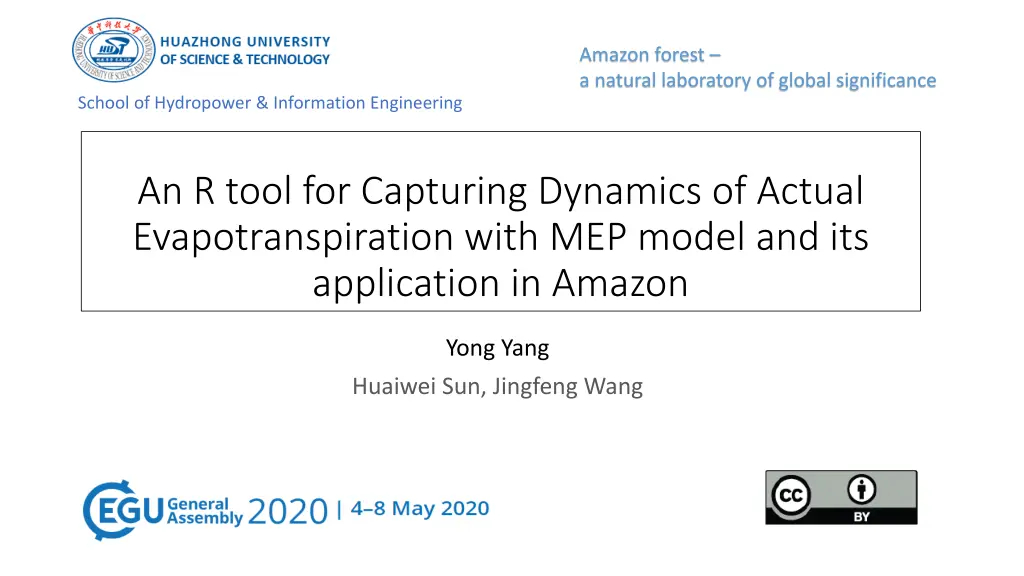
Amazon Forest Dynamics: MEP Model for Evapotranspiration
"Explore the use of the Maximum-Entropy-Production (MEP) model to estimate surface energy budget in the Amazon forest region, showcasing high performance in simulating heat fluxes. Discover how this model addresses energy imbalance issues and its application in capturing the dynamics of actual evapotranspiration. Validate results with Global Land Data Assimilation System (GLDAS) data and learn about the impressive capabilities of the MEP model in studying the Amazon ecosystem."
Download Presentation

Please find below an Image/Link to download the presentation.
The content on the website is provided AS IS for your information and personal use only. It may not be sold, licensed, or shared on other websites without obtaining consent from the author. If you encounter any issues during the download, it is possible that the publisher has removed the file from their server.
You are allowed to download the files provided on this website for personal or commercial use, subject to the condition that they are used lawfully. All files are the property of their respective owners.
The content on the website is provided AS IS for your information and personal use only. It may not be sold, licensed, or shared on other websites without obtaining consent from the author.
E N D
Presentation Transcript
Amazon forest a natural laboratory of global significance School of Hydropower & Information Engineering An R tool for Capturing Dynamics of Actual Evapotranspiration with MEP model and its application in Amazon Yong Yang Huaiwei Sun, Jingfeng Wang
Objectives and method Objectives: Estimate surface energy budget(latent, sensible and ground heat) of Amazon forest region with MEP model Test the performances of the new R tool Method: The maximum-entropy-production (MEP) model solves the turbulent sensible heat, latent heat and ground heat as the most probable partitioning of surface net radiation and satisfying the energy budget conservation. The MEP model does not require data on temperature and humidity gradient, wind speed and surface roughness and therefore is an inputs parsimonious method, using fewer parameters contrast to the traditional bulk transfer models. References: Wang, J., and R. L. Bras (2009), A model of surface heat fluxes based on the theory of maximum entropy production, Water Resour. Res., 45, W11422, doi:10.1029/2009WR007900.
Result in site scale Model Performances: MEP simulated heat fluxes vs. EC observations high R2but relative larger RMSE at half-hourly scale Eddy Covariance (EC) FLUXNET data Information about two sites of Amazon forest Site name Lat/Lon Canopy height (m) Biome type Study period BR-Sa1 2.85S/ 54.97W 35-40 Tropical rainforest 07/01/2004- 07/31/2004 BR-Sa3 3.01S/ 54.58W 35-40 Selectively logged tropical 07/01/2000- 07/31/2000 BR-Sa1 BR-Sa3
Result in Amazon region Using Global Land Data Assimilation System (GLDAS) dataset for validation Noah land surface model product(0.25 x 0.25 ), July 25, 2000,12:00 pm ~ 15:00 pm. MEP simulated MEP simulated VS.
Result of statistics Different temporal inputs of GLDAS data in estimating ET July 25, 2000,12:00 pm ~ 15:00 pm. MEP estimated VS. GLDAS data in Amazon H (W/m2) E (W/m2) G (W/m2) ET (mm/day) R2 0.63 0.90 0.76 0.90 8.11 15.56 16.31 0.53 RMSE (a) monthly ET aggregated by diurnal temporal scale (period of 1 July to 31 July 2014), (b) monthly ET aggregated by 3-hourly temporal scale (1 July to 31 July 2000) 0.50 0.61 -0.05 0.61 NSE 3-hourly simulations had a higher accuracy and smaller bias than daily simulations R2:coefficient of determination, RMSE:Root Mean Squared Error, NSE: Nash-Sutcliffe efficiency.
Conclusions Energy imbalance (about 20%) issue of energy budgt(H+E+LE=Rn) explains estimation error in Amazon forest using EC technology. The MEP model shows a high performances in simulating surface energy budget in Amazon region using 3-hourly temporal scale input, and outperforms that of daily temporal data. MEP model only need 3 input(Rn, qs, Ts) and can be implemented conveniently by our R tool. The R tool named RMEP , developed by our team and be available in R platform using the folling code: install_github("Yangyonghust/RMEP") Github access: https://github.com/Yangyonghust/RMEP
Amazon forest a natural laboratory of global significance School of Hydropower & Information Engineering Thank you for your attention! Yong Yang Contact authors : goku@hust.edu.cn hsun@hust.edu.cn jingfeng.wang@ce.gatech.edu






















